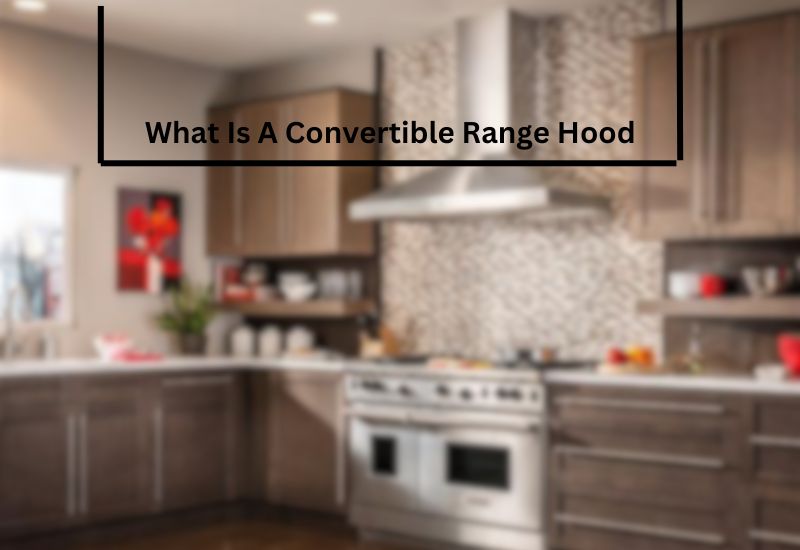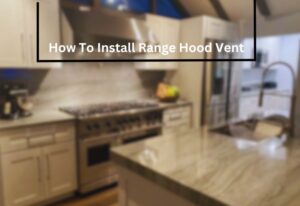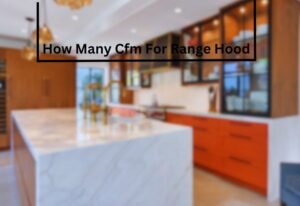A convertible range hood is a versatile kitchen appliance designed to keep your cooking space fresh and free from unwanted odors, smoke, and grease. Imagine a powerful exhaust system that acts like a vacuum for your kitchen, sucking up all the steam and fumes generated while cooking. But what sets a convertible range hood apart is its adaptability – it can be installed in different ways depending on your kitchen’s layout and ventilation options.
What Is A Convertible Range Hood? A convertible range hood is a kitchen appliance that offers flexibility in installation. It can be set up to either vent air outdoors or recirculate it indoors using filters. This adaptability allows it to suit different kitchen layouts and ventilation options.
Whether you have a ducted system that vents air outside or a ductless setup that recirculates air through filters, a convertible range hood can accommodate both, making it an excellent choice for any kitchen. This innovation ensures a comfortable cooking environment by improving air quality and enhancing your overall culinary experience. So, let’s dive deeper into the world of convertible range hoods to understand how they work and the benefits they bring to your kitchen.
Understanding Convertible Range Hoods

When it comes to maintaining a clean and odor-free kitchen, a crucial appliance that often goes unnoticed is the range hood.
A convertible range hood is a versatile kitchen accessory that provides not only effective ventilation but also enhances the overall aesthetics of the cooking space. Let’s delve into the key aspects of understanding convertible range hoods.
Versatile Ventilation Options
Convertible range hoods are designed to offer flexibility in ventilation options, catering to different kitchen layouts and setups. These hoods can be installed in either ducted or ductless configurations. In a ducted setup, the range hood expels airborne pollutants, smoke, and odors outside the home through a ventilation system.
On the other hand, in a ductless configuration, the hood uses filters to trap and recirculate air back into the kitchen after removing impurities. This adaptability allows homeowners to choose the most suitable ventilation method based on their kitchen’s layout and their preferences.
Installation and Placement
The installation and placement of a convertible range hood play a significant role in its efficiency. These hoods can be mounted beneath cabinets or suspended from the ceiling, depending on the kitchen’s design. For optimal performance, it’s important to consider the height at which the hood is installed above the cooktop.
Generally, a distance of 24 to 30 inches between the cooking surface and the bottom of the hood is recommended. This ensures proper capture of cooking fumes without obstructing the cook’s view.
Airflow and Extraction Rate
The effectiveness of a convertible range hood in removing pollutants and odors is determined by its airflow and extraction rate. Airflow is usually measured in cubic feet per minute (CFM) and indicates the volume of air the hood can move in a minute. The extraction rate should ideally match the size of the kitchen and the intensity of cooking.
Larger kitchens or those with high heat-output appliances may require a higher CFM rating for efficient ventilation. Homeowners should select a convertible range hood with an appropriate extraction rate to ensure optimal air quality and comfort.
Filtering Mechanisms
Convertible range hoods, especially those used in ductless setups, rely on filters to purify the recirculated air. These hoods typically use one or more types of filters: grease filters, charcoal filters, and HEPA filters. Grease filters capture airborne grease particles, preventing them from settling on surfaces.
Charcoal filters, often used in conjunction with grease filters, are effective in absorbing odors. HEPA filters, known for their high efficiency in capturing tiny particles, are especially beneficial for households with individuals sensitive to allergens. Regular maintenance and replacement of these filters are essential to maintain the hood’s performance.
Aesthetic and Functional Considerations
In addition to its practical benefits, a convertible range hood can also enhance the aesthetics of the kitchen. Manufacturers offer a variety of styles and finishes to complement different kitchen designs.
From sleek stainless steel options for a modern look to classic wooden designs for a rustic vibe, homeowners can choose a hood that matches their kitchen’s decor. Some range hoods also feature built-in lighting to illuminate the cooking area, adding both functionality and ambiance.
Versatility in Kitchen Ventilation: Convertible Range Hoods Explained
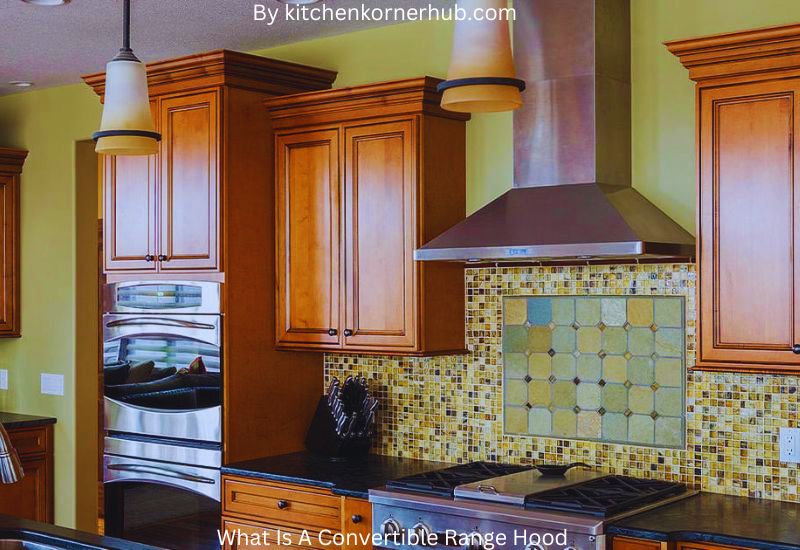
In the dynamic world of kitchen appliances, versatility and adaptability have become paramount, and this is particularly evident in the realm of kitchen ventilation. One innovative solution that has gained prominence is the convertible range hood.
This ingenious device offers a flexible approach to maintaining a fresh and odor-free kitchen environment, catering to a variety of kitchen layouts and culinary needs.
Adapting to Space Constraints: Compact Design and Multiple Configurations
Convertible range hoods address the challenge of space constraints often encountered in modern kitchens. Their compact design allows them to fit seamlessly into kitchens of varying sizes, whether it’s a cozy apartment kitchen or a spacious culinary haven.
Moreover, these range hoods boast multiple configurations, enabling both ducted and ductless installations. This adaptability ensures that regardless of your kitchen’s existing infrastructure, a convertible range hood can be installed to effectively eliminate cooking odors and airborne grease particles.
Ducted vs. Ductless: The Power of Choice
One of the standout features of convertible range hoods is their ability to transform from a ducted to a ductless setup, and vice versa. In a ducted configuration, the range hood vents air outside, effectively removing pollutants from the kitchen.
On the other hand, in a ductless configuration, the range hood employs filters to trap grease and odors before recirculating the purified air back into the kitchen. This flexibility empowers homeowners to select the ventilation method that aligns with their kitchen’s layout and their personal preferences, thus making it a truly versatile option.
Enhanced Culinary Experience: High-Performance Ventilation
Cooking is an art that demands precision and creativity, often resulting in a diverse range of cooking techniques and aromas. Convertible range hoods recognize this diversity and offer high-performance ventilation tailored to various cooking styles.
Whether you’re searing a steak, stir-frying vegetables, or simmering a savory sauce, these range hoods boast adjustable fan speeds to cater to the intensity of your culinary endeavors. This adaptability ensures that your kitchen remains free from lingering odors and excess moisture, promoting a comfortable and inviting atmosphere.
Aesthetic Harmony: Seamless Integration and Design
In addition to their functional benefits, convertible range hoods also contribute to the overall aesthetic harmony of your kitchen space. Their sleek and contemporary designs are crafted to seamlessly integrate with modern kitchen interiors.
The range of finishes and styles available ensures that you can find a range hood that complements your kitchen’s design, whether it’s a minimalist, industrial, or traditional aesthetic. This combination of functionality and design makes convertible range hoods a compelling choice for homeowners seeking both utility and visual appeal.
Environmental Considerations: Energy Efficiency and Sustainability
The versatility of convertible range hoods extends beyond their adaptability in kitchen layouts. These appliances are designed with energy efficiency in mind, employing advanced technologies that minimize power consumption without compromising performance.
Additionally, their dual-functionality design reduces the need for constant replacement of filters, contributing to a more sustainable kitchen environment. By allowing users to choose between ducted and ductless setups, convertible range hoods also provide an opportunity to make environmentally conscious decisions that align with personal values.
Adapting to Your Kitchen: The Functionality of Convertible Range Hoods
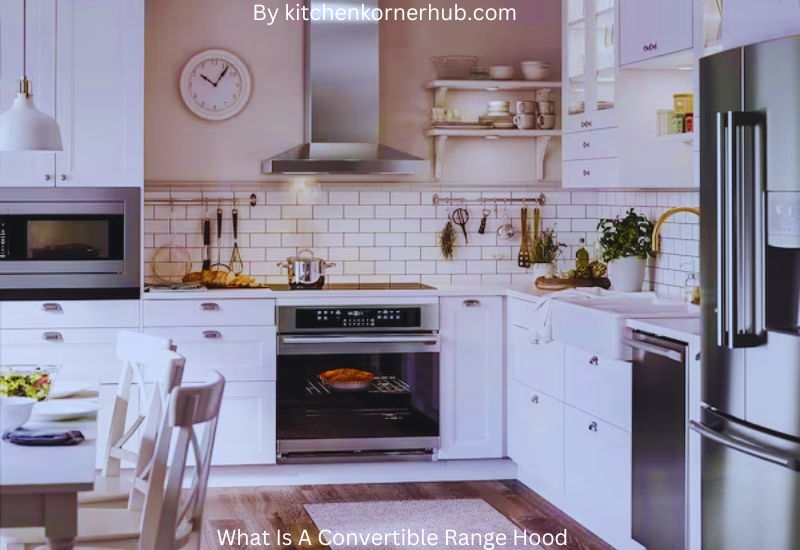
In the world of kitchen design, adaptability and functionality have become key factors in creating spaces that cater to diverse cooking styles and preferences. Among the essential components, convertible range hoods have emerged as a versatile solution that addresses the ever-evolving needs of modern kitchens.
These innovative appliances offer a range of benefits that go beyond traditional exhaust systems, making them a valuable addition to any culinary environment.
Multifaceted Design and Installation Options:
Convertible range hoods distinguish themselves through their flexible design and installation options. Unlike fixed exhaust systems, these hoods can be easily converted from ducted to ductless, or vice versa, to accommodate various kitchen layouts.
This adaptability ensures that the hood can effectively filter and remove cooking odors and smoke, regardless of whether the kitchen has existing ductwork or not. This feature is particularly beneficial for homeowners who might be remodeling or moving into a space with pre-existing infrastructure.
Enhanced Air Quality and Comfort:
Effective ventilation is paramount in maintaining a clean and comfortable kitchen environment. Convertible range hoods excel in this aspect by efficiently capturing and expelling airborne particles that result from cooking processes.
With the ability to adjust between ducted and ductless modes, homeowners can opt for the solution that aligns with their ventilation requirements. By reducing the accumulation of grease, moisture, and cooking odors, these hoods contribute to improved indoor air quality, creating a more pleasant cooking experience.
Aesthetic Integration:
Modern kitchen designs emphasize a seamless integration of appliances into the overall decor. Convertible range hoods contribute to this design principle by offering a sleek and unobtrusive presence.
Their adaptability allows for various mounting options, including under-cabinet, wall-mounted, and island configurations. This means that regardless of the kitchen’s layout, the hood can be placed in a way that complements the space while providing optimal functionality.
Energy Efficiency and Resource Conservation:
Convertible range hoods also showcase their environmental credentials through energy-efficient operation. When switched to ductless mode, these hoods often utilize advanced filtration systems, such as charcoal filters, to effectively trap and neutralize odors and contaminants.
This not only contributes to better indoor air quality but also reduces the energy consumption associated with running ducted systems. Homeowners can appreciate the balance between functionality and sustainability that these hoods bring to their kitchens.
Future-Proofing Kitchen Designs:
The adaptability of convertible range hoods resonates with the concept of future-proofing a kitchen’s functionality. As culinary trends evolve and cooking techniques change, these hoods can be adjusted to match the evolving demands of the space.
This versatility saves homeowners from investing in new ventilation systems every time they wish to update their kitchen’s layout or equipment. By seamlessly accommodating changes, convertible range hoods contribute to kitchens that are both timeless and accommodating of innovation.
Dual-purpose Ventilation: How Convertible Range Hoods Work
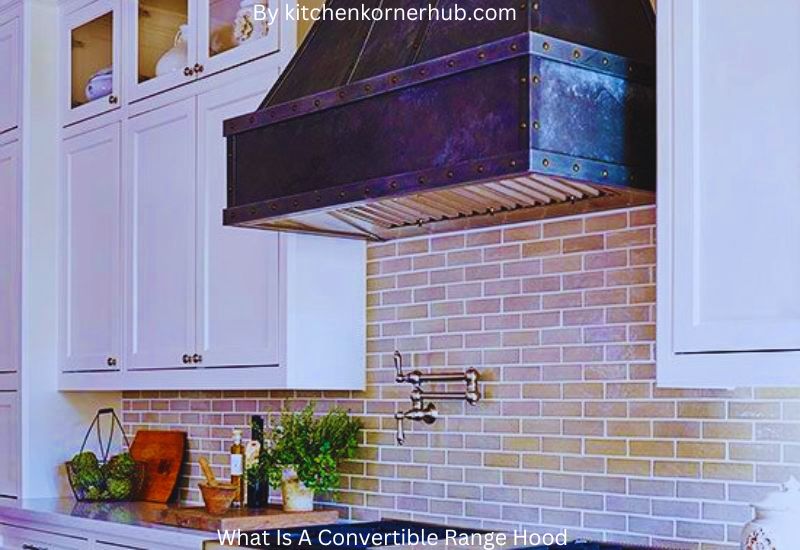
Cooking is a fundamental aspect of our daily lives, yet the resulting smoke, odors, and grease can pose challenges to maintaining a clean and comfortable kitchen environment. Enter convertible range hoods, an innovative solution that tackles these issues effectively.
These dual-purpose ventilation systems are designed to adapt to the cooking needs of individuals, providing both ducted and ductless options for efficient air purification. In this article, we delve into the mechanics of convertible range hoods and their operation.
Adaptive Airflow Mechanism
One of the primary features that sets convertible range hoods apart is their ability to switch between two distinct ventilation modes: ducted and ductless. In ducted mode, the range hood vents the air outside the kitchen through a duct system, effectively removing pollutants and odors from the cooking space.
On the other hand, in ductless mode, the range hood employs a combination of filters, such as charcoal and grease filters, to purify the air before recirculating it back into the kitchen. This adaptable airflow mechanism allows users to choose the ventilation mode that best suits their kitchen layout, location, and personal preferences.
Ducted Ventilation
In ducted mode, the convertible range hood operates similarly to traditional range hoods. It consists of a powerful fan that sucks in the cooking byproducts, such as smoke, steam, and grease, and expels them outside through a series of ducts.
This mode is particularly beneficial for kitchens with easy access to external ventilation, as it efficiently eliminates contaminants without recirculating them back into the room. Ducted ventilation is preferred in settings where the range hood can be connected to an external vent, ensuring that the air quality remains optimal.
Ductless Purification
Conversely, ductless mode provides a solution for kitchens lacking appropriate external ventilation options. Instead of expelling the air outside, the range hood captures it and passes it through a series of filters.
These filters work collaboratively to trap grease particles and neutralize odors. Notably, charcoal filters play a crucial role in absorbing odorous molecules, leaving the air fresh and clean. While ductless mode doesn’t remove contaminants as efficiently as ducted mode, it remains a practical choice for kitchens where duct installation is impractical or impossible.
Filter Maintenance and Replacement
Regular maintenance of the convertible range hood’s filters is paramount for ensuring effective ventilation. Grease filters need periodic cleaning to prevent grease buildup, which can impede airflow and reduce efficiency.
Charcoal filters, responsible for odor removal, gradually lose their efficacy and should be replaced according to the manufacturer’s recommendations. Keeping up with filter maintenance ensures that the range hood continues to function optimally, regardless of the chosen ventilation mode.
Choosing the Right Mode
The decision between ducted and ductless ventilation modes depends on various factors. For instance, if your kitchen has access to external venting, ducted mode is the superior choice due to its superior performance in removing contaminants.
However, if external venting isn’t feasible, ductless mode offers a viable alternative to enhance air quality. Homeowners must consider kitchen layout, location, and their cooking habits when deciding on the appropriate ventilation mode for their convertible range hood.
Choosing the Right Ventilation Option: Ducted vs. Ductless Convertible Range Hoods
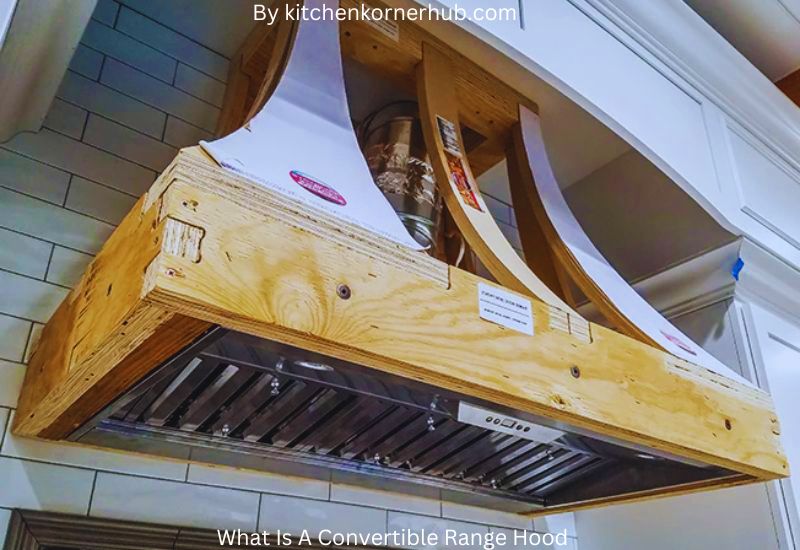
In modern kitchen designs, the choice of a ventilation system holds significant importance, as it directly impacts air quality, odour control, and the overall cooking experience.
Two popular options that homeowners often contemplate are ducted and ductless convertible range hoods. Each type comes with its own set of advantages and considerations, making it crucial to understand the nuances before making a decision.
Ducted Range Hoods: Optimizing Air Quality and Efficiency
Ducted range hoods, also known as vented or exhaust hoods, operate by extracting cooking pollutants, grease, and odours through a duct system that leads to the outdoors. This option offers optimal air quality, as it effectively removes airborne particles and directs them away from the kitchen environment.
Ducted range hoods are particularly beneficial for homes with heavy cooking activities, as they maintain consistent ventilation performance regardless of the types of foods being prepared. However, their installation can be more complex and expensive due to the requirement of an exterior duct, making them ideal for kitchens with direct access to an exterior wall.
Ductless Convertible Range Hoods: Versatility and Easy Installation
Ductless convertible range hoods, also known as recirculating hoods, utilize filters to trap grease and odours before recirculating clean air back into the kitchen. These hoods are known for their versatility, as they can be installed in various kitchen layouts, even in spaces without access to exterior walls.
Their installation is simpler and more cost-effective compared to ducted hoods since they don’t require extensive ductwork. However, while they do improve indoor air quality to some extent, they might not be as effective as ducted hoods in completely eliminating cooking odours and particles.
Performance and Efficiency Considerations
When comparing the two options, it’s important to consider the performance and efficiency aspects. Ducted range hoods excel in removing cooking byproducts efficiently, maintaining air quality, and preventing the accumulation of grease on surfaces.
On the other hand, ductless convertible hoods might struggle to match the same level of performance, especially when dealing with high-heat cooking methods that generate more smoke and vapours.
Maintenance and Filter Replacement
Another crucial factor to contemplate is maintenance. Ducted range hoods generally require less frequent maintenance since their primary focus is on expelling air outside.
On the contrary, ductless convertible hoods demand regular filter replacements to ensure their efficacy in capturing grease and odours. Ignoring filter maintenance could lead to reduced performance and compromised air quality in the kitchen.
Making the Decision: Kitchen Layout and Cooking Habits
The final decision between ducted and ductless convertible range hoods should be based on your specific kitchen layout and cooking habits. If your kitchen has access to an exterior wall, a ducted range hood is likely to provide superior performance.
However, if your kitchen lacks such access or you require a more flexible installation, a ductless convertible hood could be the pragmatic choice.
Conclusion
In conclusion, a convertible range hood stands as a versatile and essential kitchen appliance designed to maintain air quality and enhance cooking experiences. With its ability to adapt between ducted and ductless configurations, it offers flexibility for various kitchen setups. By effectively removing smoke, odors, and airborne particles, it promotes a healthier environment and ensures a pleasant cooking atmosphere. The choice of a convertible range hood grants homeowners the convenience of tailoring ventilation solutions to their specific needs. As kitchens continue to evolve, this adaptable appliance remains a crucial element in maintaining both culinary comfort and overall indoor air quality.
Frequently Asked Question(What Is A Convertible Range Hood)
What is the difference between a ducted and convertible range hood?
The main difference between a ducted and convertible range hood lies in their ventilation systems. A ducted range hood, also known as a vented range hood, expels cooking odors and smoke directly outside through a duct. It’s a more effective option for maintaining a fresh kitchen environment as it eliminates pollutants completely.
On the other hand, a convertible range hood offers flexibility by allowing you to choose between ducted and ductless modes. In the ductless mode, the hood filters the air and recirculates it back into the kitchen, which is useful if duct installation is not feasible. However, this method is generally less efficient in completely removing odors and smoke compared to a ducted system.
What are the two types of range hoods?
There are two primary types of range hoods: ducted (vented) range hoods and ductless (recirculating) range hoods. A ducted range hood removes cooking byproducts through a ventilation system that expels them outside, making it highly effective at maintaining a clean and odor-free kitchen environment. On the other hand, a ductless range hood doesn’t have a duct leading outside.
Instead, it uses filters to capture grease, smoke, and odors, and then recirculates the filtered air back into the kitchen. While ducted hoods are generally more efficient, ductless hoods can be a practical solution when duct installation is challenging.
What is a convertible under cabinet hood?
A convertible under cabinet hood is a type of range hood that offers the flexibility to operate in both ducted and ductless modes. It’s designed to be mounted underneath a cabinet above the cooking area. In ducted mode, it vents the cooking byproducts outside through a duct system.
In ductless mode, it uses filters to trap grease and odors, then recirculates the cleaned air back into the kitchen. This type of hood is particularly useful when you want the option to change between ventilation methods based on your kitchen’s setup and needs.
What is the difference between range hood and vent hood?
The terms “range hood” and “vent hood” are often used interchangeably, but they refer to the same kitchen appliance. A range hood, also known as a vent hood or extractor hood, is a device installed above your stove or cooktop to capture and remove airborne grease, smoke, odors, and other cooking byproducts.
It contains a fan that helps pull the air and pollutants through filters, either expelling them outside through ductwork (ducted mode) or filtering and recirculating the air back into the kitchen (ductless mode). So, while the terms are used interchangeably, they both describe the appliance responsible for maintaining air quality during cooking.

